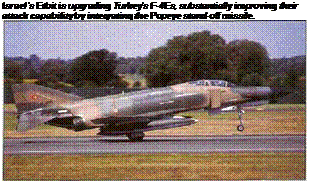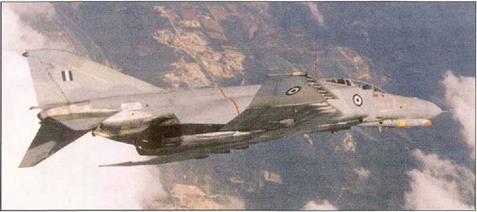McDonnell Douglas F-4 Phantom миш-гоіе combat aircraft
|
|
T |
he McDonnell F-4 Phantom was originally designed as e shipboard interceptor for the USN and USMC. The prototype (XF4H-1) first flew on 27 May 1958. The first production version was The F-4B None of the naval versions remain in jse as fighters and even the handful operated by test agenc:es have now been_retired. saving only QF-4INI/S drones in service. I he USAF’s initial F-4C variant was followed by the F-4D optimised for air-to-ground operations. All US F-4C/Ds have been retired, but the model remains active n Iran end Sooth Korea.
The definitive F-4E for the USAF first flew in June 1967, and introduced a 20-miri cannon fitted under the nose. F-4Es remains in service with Egypt, Greece, Iran, Israel, South Korea and Turkey. The type has been withdrawn from US service and many have been converted to QF-4E target drones.
The F-4G ‘Wild Weasel’ anti-radar variant resulted from the conversion of 116 F-4E airframes. Deleting the integral cannon and adding an APFi-38 RHAWS. They were the last US Phantoms to see active service, in the 1991 Gulf War. The survivors have been converted to QF-4G drores.
Five irso’ Pnantom operators have upgraded their surviving aircraft, extending airframe ives and adding modern radar, improved avionics and self- defence systems. In the mid-1980s Israeli launched the Kurnass 2000 upgrade, which adds a completely new mission avionics package to ts
remaining F-4Es and RF-4E/RF-4E(S) Oref (raven) reconnaissance aircraft. Israel is now upgrading Turkish F-4Es to Phantom 2000 standard with EL/IV1-2032 multi-mode radars, a digita cockoit anc enhanced weapons capability.
The Luftwaffe’s F-4F ICE (Improved Combat Efficiency) upgrade added the APG-65 radar and AMRAAM capability to about 150 aircraft. DASA is also upgrading 39 Greek F-4Es to a similar level, under the Peace Icarus programme. Japan operates about 90 upgraded F-4EJ Kais, with APG-66 ‘adars, expanded weapons capability and updated avionics.
The reconnaissance-configured RF-4Cand RF-4E have a modified nose housing ootical cameras, e. ectronic equipment,. IR sensors and a mapping/ terrain avoidance radar. RF-4Es remain active with Greece, Iran, Turkey and Israel, while Spain operates modernised RF-4Cs. Israel’s armed RF-4Es are equipped with ndigenous reconnaissance and avionics equipment and have fixed refuelling probes. Japan operates 14 UQgraded RF-4EJ Kais with new radars and modernised recce systems.
 Specification: McDonnell Douglas F-4E Phantom II
Specification: McDonnell Douglas F-4E Phantom II
Powerplant: two r9.82-klN (17,900-lb) General Electric J79-GET7A afterburning turbojets Dimensions: wing span 11.71 m (38 ft b n), length 19.70 n (03 ft); height 5.02 mfl6 ft 5/ in) Weights: basic empty 13757 kg I33.328 ib); combat take-off 18818 kg (41,487 lb): maximum take-off 28C30 kc (51,795 lb) Performance: maximum level speed 2393 kmh (1,485 mpn), maximum rate of climb a: sea level 18715 m (31,400 ft) per minute: service ceiling 18Э75 in [62,250 ft); area interception combat radius 1266 km (786 miles)
Armament: one V151 20-mrr cannon with 640 rounds, maximum ordnance 7253 <п 116.0DCI lb!












